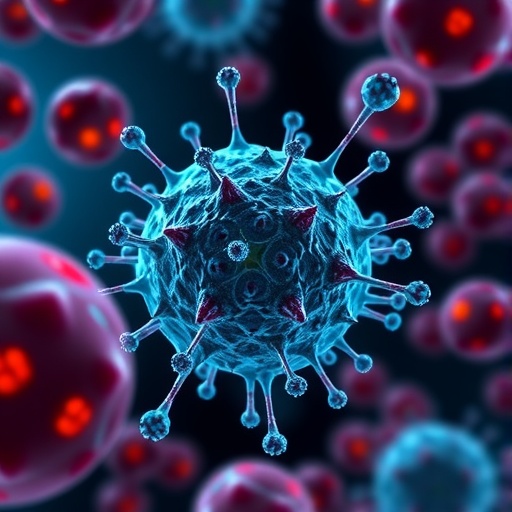Deep within the nucleus of leukemia cells, a remarkable discovery is rewriting the narrative of cancer biology. What once appeared as inexplicable molecular chaos now reveals a sophisticated physical architecture underpinning disparate leukemia mutations. This breakthrough centers on a novel nuclear structure whose unifying properties could redefine therapeutic approaches for one of the most challenging blood cancers.
Leukemia, a disease arising from genetic aberrations in hematopoietic cells, has traditionally been studied through its varied mutations and associated molecular pathways. However, patients harboring vastly different genetic changes often manifest convergent gene expression profiles and respond similarly to select treatments, hinting at an underlying commonality. The question that perplexed researchers for years was whether a hidden cellular principle could unify these seemingly heterogeneous forms of leukemia.
In a pioneering collaboration, the laboratories of Dr. Joshua Riback and Dr. Margaret Goodell at Baylor College of Medicine embarked on a mission to elucidate this mystery by probing the physicochemical underpinnings of leukemia. Riback, notable for his expertise in protein phase separation mechanisms, teamed with Goodell, a distinguished figure in hematopoietic stem cell biology and leukemia pathogenesis. Their combined efforts represented a confluence of physics and molecular biology, aiming to link cellular biophysics with oncogenic gene regulation.
The breakthrough came with graduate student Gandhar Datar’s meticulous high-resolution microscopy work, revealing that nuclei from leukemia cells housed distinct, bright puncta—structures entirely absent in normal hematopoietic nuclei. These structures, described as “coordinating bodies” or C-bodies, represented phase-separated nuclear compartments enriched with mutant leukemia proteins alongside a consortium of wild-type proteins. This ensemble co-localized molecular constituents critical to the sustained activation of leukemia-driving gene networks.
Phase separation, a principle borrowed from physical chemistry describing how immiscible substances segregate to form droplets—much like oil partitioning itself in water—provided the conceptual framework to understand C-bodies. Within the cell nucleus, these membraneless condensates operate as regulatory microenvironments, organizing and concentrating factors required for oncogenic transcriptional programs. Their formation depends sensitively on protein-protein and protein-RNA interactions tuned just so—akin to a delicate molecular equilibrium producing precise droplet consistency.
Perhaps most striking was the observation that leukemias driven by entirely distinct mutations nonetheless formed C-bodies with nearly indistinguishable biophysical properties. This revelation emerged from innovative quantitative assays developed by the Riback Lab, demonstrating uniform droplet behavior despite heterogeneous mutational landscapes. The implication is profound: diverse genetic lesions funnel into a shared biophysical substrate that maintains the malignant state.
Further experimental manipulation lent credence to the functional indispensability of C-bodies. Genetic perturbations disrupting the phase separation capacity of leukemia-associated proteins led to disintegration of these nuclear condensates. This collapse halted cancer cell proliferation and promoted differentiation into mature, non-malignant blood cells. Complementing genetic approaches, pharmacological agents capable of dissolving these droplets recapitulated similar therapeutic effects, highlighting the condensates as viable drug targets.
The universality of this phenomenon was confirmed through extensive analyses utilizing human leukemia cell lines, transgenic mouse models, and primary patient samples, solidifying the central role of C-bodies in disease biology. Moreover, the presence of these nuclear compartments in patient cells provided a tangible morphological hallmark that could bridge mechanistic insights to practical diagnostics and treatment strategies.
By framing leukemia mutations around a shared, phase-separated condensate, this study introduces an entirely new dimension to cancer therapeutics. Instead of targeting individual genetic aberrations—which are numerous and complex—future interventions could focus on modulating the physical properties of C-bodies, effectively undermining a fundamental organizational hub of the leukemia transcriptome. Such an approach promises a broader spectrum of efficacy and a potential reduction in resistance mechanisms that plague mutation-specific drugs.
Beyond leukemia, the discovery raises the tantalizing prospect that other diseases, particularly neurodegenerative disorders like ALS, may similarly rely on formation of biophysically analogous droplet-like nuclear or cytoplasmic structures. This opens vistas for generalized therapeutic paradigms grounded in the physics of biomolecular condensates, rather than exclusively on their molecular composition.
This landmark discovery was enabled by multidisciplinary collaboration and supported by numerous institutions committed to cancer research. The intersection of molecular biology, biophysics, and clinical science in this work exemplifies the future direction of biomedical research—where comprehending the physical nature of cellular organization yields novel insights and treatment avenues that transcend conventional genetics alone.
As we gain deeper understanding of how C-bodies orchestrate oncogenic programs, the vision of therapies that dissolve these condensates and restore regulatory balance comes into sharper focus. This physical targeting strategy could usher in a new era in leukemia care, moving from fragmented mutation-specific approaches toward a unified treatment grounded in cellular biophysics.
The revelation of C-bodies heralds a paradigm shift, turning the once elusive intracellular complexity of leukemia into a decipherable and targetable physical framework. In doing so, it shines a light on the intricate dance between physics and biology that governs disease—and offers hope for innovations capable of transforming patient outcomes in leukemia and beyond.
Subject of Research: Animals
Article Title: Disparate Leukemia Mutations Converge on Nuclear Phase-Separated Condensates
News Publication Date: 4-Nov-2025
Web References: DOI: 10.1016/j.cell.2025.10.010
Keywords: Life sciences, Biochemistry, Biophysics, Cell biology, Developmental biology, Molecular biology
Tags: cancer biology breakthroughscollaboration in leukemia researchconvergent gene expression in leukemiagenetic aberrations in hematopoietic cellshematopoietic stem cell biologyhidden nuclear droplets in leukemialeukemia pathogenesis researchmolecular chaos in leukemia cellsnovel therapeutic targets for blood cancerphysicochemical underpinnings of cancerprotein phase separation mechanismstherapeutic approaches for leukemia





